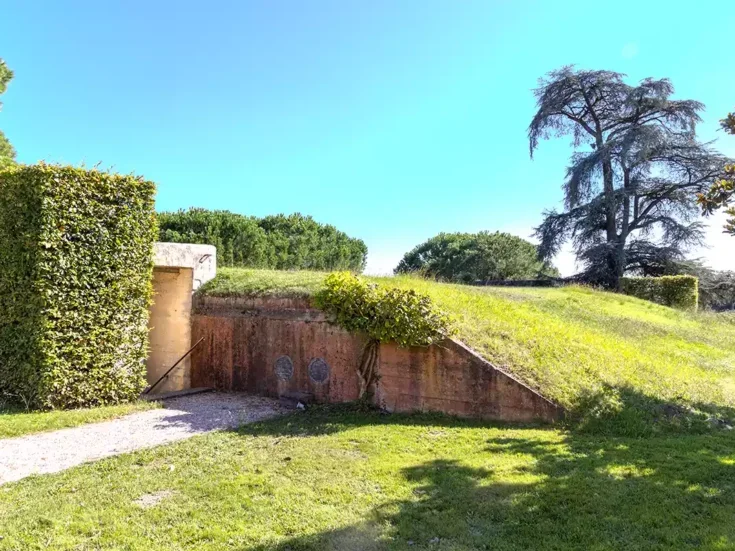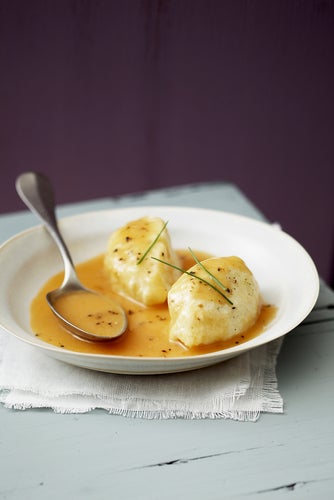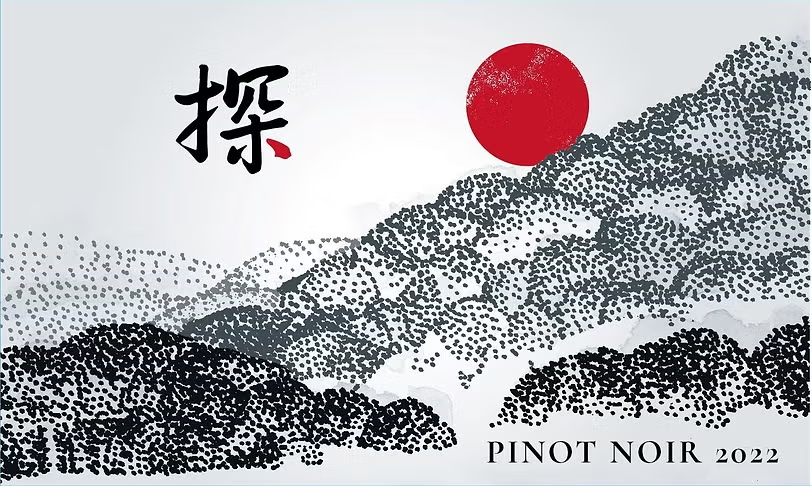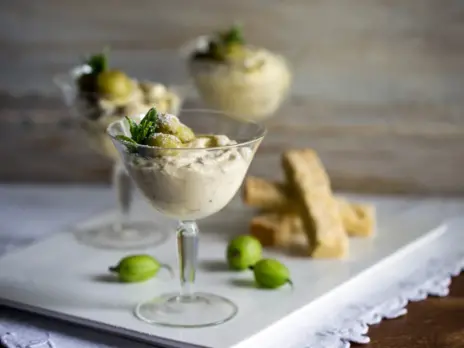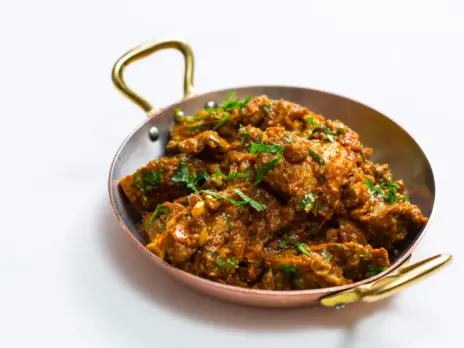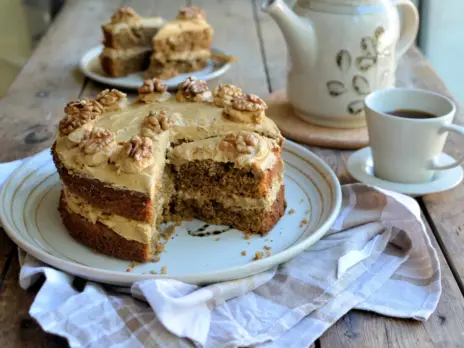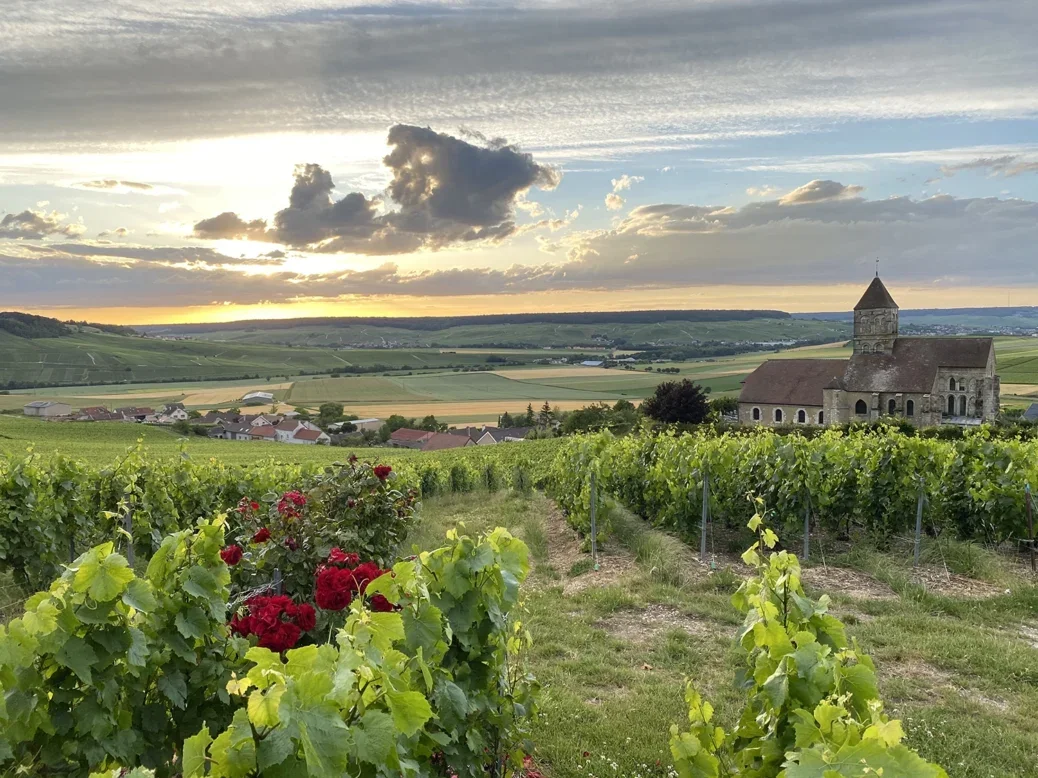
Terry Theise tastes his way through a set of quietly virtuosic fine wines from Champagne Pierre Gimonnet et Fils.
I sometimes wonder if Gimonnet is really “understood,” notwithstanding their market success. I suspect the estate’s essence, the particular way they enact terroir, is too little attended to. And I suspect (with sinking stomach) that many young tasters find the wines too “conservative” and don’t know how to respond to something that’s clean and technically correct. Man, I hope I’m totally wrong about that. More thoughts along this line will appear within the tasting texts, as they came to me spontaneously. But to summarize them, I’d say that Gimonnet’s Champagnes impress drinkers who do not need wines to be “impressive.” The key word being “need,” because we all enjoy impressive wines, but I do not require that particular entertainment, when wines are as fine as these are.
Put it this way; there’s a perfect volume to play music, in which it is present enough to get your attention but not so loud as to commandeer it. If the music is compelling or enticing enough, you notice and listen. You are pulled in. Is this as lovely as it seems? As fascinating? In contrast, music played loudly can be fabulous—can be—but you either surrender to it entirely, delaying whatever it was you were already doing, or you say “Not now,” and turn it off.
I will always prefer to be drawn in, because it harkens back to an exquisite moment in childhood, when you are welcomed to absorption. Is there anything, anything more beautiful than a child lost to the world, in the thrall of a fascinating spell? I think I love Gimonnet’s wines as I do because, even at their most intense, they whisper and croon, and I enter the silvery world they offer.
There’s much to be said for experience and observation—not to mention maturity. Tasting the two zero-dosage cuvées—which are extraordinary, by the way—I had to wonder at the prevailing miseries of so many “zero” Champagnes, and what Gimonnet knows that those callow (or luckless) growers don’t. He’s making it look easy, but it isn’t easy.
Champagne is a dramatic example of needing to consider how a wine might develop, in this case when disgorgement issues are behind it. With several of these I was tempted to put a “plus” in parentheses, to indicate what I thought would be a wine’s ultimate quality, but I decided not to. That’s what words are for. I’d rather tell you what I believe you’ll encounter if you drink the wines now, as I’m doing.
The cuvée “Paradoxe” appears to be a thing of the past. Didier always had second thoughts about whether to produce a blend of CH/PN—hence its name—and when he discontinued it I wasn’t surprised. That said, a small tribute is in order. That wine was really lovely. It both was and was not inherently a Gimonnet wine; it had his grace and class, but obviously not his flavors.
With the top wines, we had to “consider” the 2015 vintage, a sugar-ripe year that ended up physiologically unripe, with attendant grassy flavors you either accepted or did not. Rodolphe Peters was unwilling to even permit me to taste his Chetillon, though I liked the Mont Joly quite well, and I find myself wondering at the forgiving nature of the Champenoise—growers and negoçiants alike—when an entire vintage has weird flavors that arguably don’t belong in Champagne. We’re not talking about better and lesser years. We accept those. We’re talking about vintages that introduce extraordinary flavors such that the prevailing template of the wine is distorted.
As such, I have to make an effort to wrench myself away from the question of what you should buy. I have no idea what you should buy. It’s clear what my favorites are, but your taste may be different. This is a survey or the current collection from a grower for whom I have unqualified respect and a man I hold in affection and esteem. It has wines of differing types, according to vintage. Some of it isn’t what I’d call “classic,” but the daily-drinking wines are in order. My unguarded opinions are here, and you can decide whether they have any value as “guides” or whether they simply tell a story—here’s how it was, this time. See you next time!
Listed in the logical sequence, but tasted in separate flights each of which went bottom-to-top—to avoid bunching all the top wines together in one sitting.
Tasting the wines of Pierre Gimonnet et Fils
Gimonnet’s Non-Vintage wines
Brut Extra, Extra Brut 1er Cru, NV
All Cuis, based on 2017 with reserve wines 2015-2010, disg. 7/21/2021. Diam cork.
While I have struggled with this wine in the past, here the 2017 fruit pulls it out from under its usual angularity—that plus 20 months on the cork. (Whether this is the currently available cuvée for sale in the US I do not know.)
Compared with the laser-precision and pointed attack of a (superb) grower like Suenen, Gimonnet’s wines all convey a kind of tact. They are comparatively discreet, as part of a generally quiet cordial nature, within which many universes of nuance can be seen. This wine has most of this estate’s cardinal virtues, compromised only by a finishing sourness that certain drinkers will relish.
Gimonnet’s are wines of the shade of a bright day, such that your eyes are relieved to get out of the glare, and the shade is like a balm. They speak in what we call “inside voices.” And they have a great, great deal to say.
It has the Cuis coolness and the basmati starchiness and fragrance, along with apples and ginger; indeed it has everything there is to cherish about these lovey Champagnes—except seamlessness, which apples to my sense of a wine’s balance. Didier will be surprised, but I wonder if this wine isn’t dry enough. But it knits nicely together in the MacNeil Crisp & Fresh glass.
So it’s a pretty good edition of this wine, but I remain baffled that anyone would prefer it to the “regular” Cuis NV.

Cuis 1er Cru, Brut NV
The back label has a figure missing, so I don’t (yet) know the base-vintage; disg is 12/22/2021, so it could be either ’18 or ’17, going back to 2010. Diam cork.
I know it isn’t precisely apple-to-apple, but the difference in sweetness between this and the Extra Brut is just TWO Grams per liter. And of course it tastes drier than the XB because the sugar is better balanced and melts into the wine. Tasting it my guess is it’s 2018-based, only because of its immaturity, that piqued quality that says a Champagne is too young.
It has in fact a magnum-like profile, the excessively cerebral strictness of a young Mag. It also has atypical force for this wine, which always shape-shifts with air and/or bottle-age. The finish shows the ghee-butteriness that reminds me of an aspect of the Fleuron flavor.
Here’s what I need to do before I die; taste a range of eight to ten bottlings of this cuvée with at least five years on the cork (if not longer), because no other Champagne that I know is as misleading as this is in its first youth. But I’m persuaded that this rendition will always be markedly roasty among its peers, and that the few years I hope to convince you to wait for it shall deliver three times the quality you paid for.
Some of that is in evidence on my second look, three days later. But, classically, this youngster has two disparate pieces that don’t join, a roasty ripe-fruit savor that appears early in the finish, and a spiky steely note that comes after. The fragrances are encouraging, and I continue to feel this beauty is simply finding its way. If you drink it now, use a “white-wine” glass to bring its low notes and mid-plate mineral forward.
Cuis 1er Cru, Brut NV MAGNUM
Multi-vintages from 2017 back to 2010, disg. 12/2/2021, diam cork.
It has the “young-magnum” nose. You know what I mean; steel and snarl. Yet the palate is another thing again. It is, in short, the reason for cherishing magnums. But it’s so striking, the difference. This time I tasted the Mag right after the bottle; as far as I can see the wine is the same in both. But this one smells like it was bathed in the Urgestein twang of Wachau Rieslings. Little fruit to speak of, just pepper-pepper-pepper.
It isn’t shocking the vessel size would act upon a wine’s development, and while they are never identical (Mags and 750s) they do converge a bit more closely over time. The Magnum will always be more complex, more mineral, more tangibly structured, and correspondingly less fruity and less (positively) oxidized.
I think all Champagnes should be bottled in Liters. That’s what I think. A bottle is never enough and you gotta wait a freaking decade for a Magnum. Just sayin’.
That doesn’t mean this one is flattering, at least not yet. But it offers an entirely different key signature and register than its brother in the 750. It is a riot of chalk and blatant mineral and sel gris pestled to dust. The texture is currently quite strict, but we know that will change. What’s really striking is the way the larger format completely alters the will and nature of the wine, as if it had distilled each scintilla of chalk into a sharp point of expressiveness.
Fruit tends to follow, but I shy away from assuming I know how any given wine (or bottle) will develop. Keep this a few years and then yell at me if I was wrong. A pleasant herbal note arrives on my second sampling. When this is mature it may have a few delicious secrets to tell us about Cuis.
Sélection Belles Année, Brut 1er Cru NV +
Remember this is in effect an “alternate” NV, described as multi-vintages, mostly 2019, disg. 2/9/2022. Diam cork
One feels bullish about ’19! You have to love that toasted-brioche fragrance and a flowering-fields thing that resembles certain elegant Grüner Veltliners.
On the palate, well, you have something to consider, because this is the freshest disgorgement of all the wines I’ve tasted thus far and yet it’s the most available and gracious to the drinker. It has to be a question of blending, unless ’19 is exceptionally affable.
I don’t remember a better version of this wine. It flips the script, putting fruit and savors front and center and minerality and citricity at the back. In that sense it presents as less “grower-y” but you’d have to wonder what negoç could possibly create such a deft and particular NV. Still, to refer to fruit is even misguided because what it actually shows is a warm spicy savor; brown butter and cardamom and nutmeg and Reggiano.
In short, it’s a multi-dimensional wine that’s interesting but not demanding. The finish is lovely and long. The dosage—in the extra-brut range but not so labeled—is ideal. It’s a Gimonnet wine that needn’t be studied, a simple pleasure that is by no means simple.
Gimonnet’s Vintage wines
Gastronome 2018 1er Cru +
39% Cramant, 24.5% Chouilly, 3% Oger, 33.5% Cuis and Vertus; disg. 10/12/2021
Often the passionate introvert of the lineup, and the most particularly mineral in its profile, the ’18 vintage has delivered unusual torque and fruit. No problem with that!
This is simply beautiful Champagne. It isn’t quintessentially a beautiful Gimonnet Champagne, yet it couldn’t be anyone else’s either.
I’m forming a tentative hypothesis about ’18 Chardonnays; for all the fruit they provide, they also carry quite a phenolic kick on the finish. (This was also true of the German Rieslings, for what it’s worth.) And for whatever reason, probably temporary, it’s the Chouilly that shows most expressively here. But my goodness, this offers nearly everything there is to adore about Blanc de Blancs Champagnes—and we all know that the true bubble-heads love BdB above all others.
I’ve written tasting notes for at least twenty five editions of this wine, so I’ll spare you the detailed associations. You’ll get the special kelpy-osmanthus thing from oolong teas, the heirloom apple and the yuzu, and from ’18 we get cardamom and tangelo. But most important, you’ll have a deftness and a confidence and an egolessness that shows a wine comfortable in its skin and a grower who really has nothing to prove any more.
My wife has known Gimonnet Champagnes as long as I have, and I poured us a couple small glasses while dinner was cooking last night. She agreed that the wine was “ridiculously good.” The kitchen was fragrant (we had brown basmati, trumpet mushrooms, and cauliflower cooking, three burners burning) and it would have been easy to slug-and-glug. But one sip and we just shook our heads—what a gift this wine is!
For all that it’s an unusual gastronome, I adore it and find it reassuring, that such a cordial and fetching creature still walks the world.
Oenophile Non Dosé, 1er Cru, Brut Nature, 2016 ++
70% Grand Cru (Cramant-Chouilly-Oger) and 30% Cuis, disg 10/2021
This has appeared or will soon appear on the market, as the (upcoming) 2008 is nearing its end. It’s relatively fresh for this cuvée, but I do like ’16. And Didier is one of the few to have the touch with zero-dosage wines.
Put it this way: Everything that’s exposed here is something you’re glad to see naked. He makes it look so easy you have to lament how few people seem to be able to do it.
It’s not like ’16 was ripe and fluffy. It was tensile and thready, with acid-driven tree fruit (mirabelles mostly) and a general lack of hedonism. But here we enjoy an umami-driven balance and a wonderfully toasty tertiary finish—the influence of the Grand Cru is evident—and finally some ineffable thing that’s pure Gimonnet, a place where nothing is ever brash or obvious, even the things we like, such that there’s a soft focus herbal-mineral-citric interplay that’s always expressive yet never shoved in your face. “Dude, look at my amazing minerality! Check out my focus!! Feel your pupils shrinking? I am the shit!!”
If you ever ask yourself the question, what kind of company is this wine keeping me, with Champagne Gimonnet the frequent answer is, the best possible kind. Clearly it has a lot to say, and clearly it refrains from yacking about itself. It settles you. I find I am reassured that a wine exists that’s so grown-up without being rigid and dour. It’s also a Champagne made for west-coast oysters, which happen to be my favorites.
I confess I challenged myself, and the wine, to prove that I hadn’t been seduced somehow. I’ve always liked this cuvée, but never this much. But nope—it’s all that.
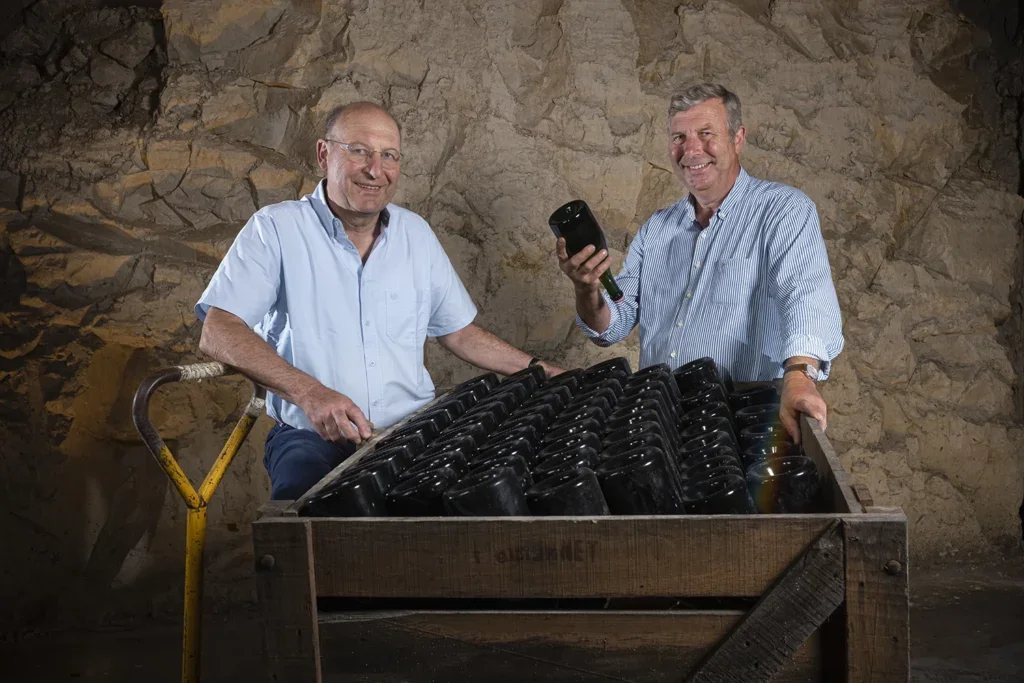
Oenophile Non Dosé, Brut Nature, 1er Cru, 2008 ++
A striking 76% Grand Cru, with 14% 1er Cru (both Cuis and Vertus), disg 10/18/2021
Didier is a believer in 2008. One sees why!
Mind you, twelve years of tirage will do good to a lot of Champagnes, but this is in fact a masterpiece. It’s more starched than the ’16, less congenial, but concomitantly more profound and impressive. I wish I had it in my cellar—both of them, actually.
I have a decidedly minority opinion about ’08. Eventually I may be revealed as a fool, but I truly do not think so. (And I just drank a bottle of 2008 Krug, a great Champagne, and the echo of that masterpiece doesn’t quite efface my suspicion that we misunderstand 2008 because it is so impressive. It seduces us away from reason and precedent.)
Mind you, this tangent mustn’t obscure what a superb wine we have here. And there are many ‘08s like it—superb. Misleadingly so, I think. Vintages like ’08 scorch your soul, passionately, but the ostensibly simpler vintages like 2009 go the distance. I learned this lesson back in the 90s, when I insisted that Germany’s ‘96s were profound, whereas the 1997s were simple in comparison. Only Rudi Wiest extolled the virtues of ’97, and I thought he was nuts.
He wasn’t nuts, he was correct. To geek out over minerality or the dubious dynamism driven by acidity is a symptom of an immature palate. Great vintages always live farther from the edge. And a youthful serenity can be trusted. End of sermon.
I’d have to drink several hundred non-dosé Champagnes to locate two as marvelous as these are. This one is for lovers of Chablis of the old school, wiry and raw boned and salty and drier than dry. Charm? We don’t have no stinkin’ charm.
Oger Grand Cru Expression d’un Teroir, Brut, NV +
In fact all 2019 (!), disg 11/17/2021, from four lieu dits identified on the back label; diam cork
Of all the communes in the Côte des Blancs, Oger is the one that feints most vividly towards white Burgundy. This ’19 seems tailor made for it. The toasty generosity of the year, the toasty generosity of the terroir—it’s almost too good.
Yet it’s a Champagne that gives a robust pleasure that’s overt and generous, but is it as simple as it seems? I don’t think so. But you have to think about it when you’re tasting, as it’s easy to be seduced by its hale and giving nature. Pause a moment before the finish, and you’ll find two lovely stanzas of minerality that echo into an ethereal and deliberate coda. The wine has cling. A wine as generous as this can indeed be smart, and it only seems easy. In the several years this cuvée has existed, this is the best of them.
Here’s an anomalous notion. In a certain way, Oger answers Didier’s curiosity that led him to create a Pinot-driven wine like the “Paradoxe.” It is truly an Other compared with his home-terroirs of Cuis-Chouilly-Cramant, yet it bends to his bidding, or he bends to its.
Fleuron, 1er Cru, Brut 2017 ++
The “regular” vintage wine; 72% Grand Cru, 28% 1er Cru, disg. 10/18/2021
It’s the exotic in the range, all Satsuma and persimmon and a curious sort of floweriness that presents as lychee and rose, but not exactly the way Gewürztraminer does.
The best way to say this is, it’s a kick-ass vintage of Fleuron. The aromas do not prepare you for the swollen attack on the palate. But it isn’t aggressive, just generous and extroverted and tangible.
Didier has reached a point in life where his grown kids are working at his side, and you can imagine what that’s like. Relief: they’re here. Tact: they have to find their own ways and try their own ideas. Pride: But the old man has a few more tricks up his sleeve. I mean, how could anyone drink this Champagne and think “Well that needs to change…?’
I find it moving, when you taste from an estate that is clearly in-the-zone, but what seems clear now is a through-line from Belles Année to here, as if this wine is the older sibling of that one. It has the element chefs call “caramelization,” when a Maillard reaction occurs (as best I understand it), and it also has actual fruit, apricot, and plum.
In the end it has a thing I can only describe as an ether of honey. It’s spicier and more vertical from Juhlin 2.0, and I could imagine if you had it from, say, a Jamasse glass it would be like a potion of malt. (If this seems geeky to you, the question of what’s the “proper” glass for Champagne remains debated, and no consensus has emerged. The “Jamasse” glass was crafted by the sommelier at the Crayères in Reims, and its effect is to flatter whatever’s served in it.)
Special Club wines
Special Club, Oger Grand Cru, 2015
Disg Oct. 2021, contributing lieu dits appear on the back label.
2015, to refresh your memory, was the curious ripe-yet-green vintage that presented…not exactly pyrazine notes (this was no 2011, thankfully) but sweet-green yuzu notes atypical (and thus unwelcome) in Champagne. The question is, what will happen to this vintage over time? The deeper question is, can we accept these aromas and flavors in “Champagne?”
That accounted for, this Oger seems pretty damn classic at first glance. That impression, though, is fleeting with repeated sampling. The power of ’15 is present and the green of the vintage is a nuance I must confess is almost pleasing. “Almost.”
It shows more in the Juhlin 2.0 (which exaggerates everything, usually beneficially), but even then it isn’t annoying. The regular Juhlin gives us a wonderfully mineral wine, even despite its assertiveness. It has the easy authority a Special Club should have. I’d disagree if you insisted my sense of what Champagne “should” taste like is overly narrow—I know where to find green flavors whenever I thirst for them—and I’d respond that you’re blurring lines better left clear and focused.
If “brioche” is a typical descriptor for Champagne, then Oger shows toasted brioche, and that is so expressive here, astride its minerality, that the vintage greenies are almost completely subdued. And yes, there’s that word almost again.
I tasted it again right after the other Oger, and this time its green notes were more present. 2015 is not ’11—which is to say it’s not appalling—but it is abnormal, and while I’m pleased with its unlikely successes, I won’t mind seeing the back-end of it.
Special Club Chouilly Grand Cru, 2015 +
100% Montaigu, a superb climat with (in this case) vines planted in 1951 and 1991, disg April 2021
This is one of those wines that throws you back to the starting gate. I had sometimes questioned whether Chouilly was really a stand-alone commune, and I’ve certainly fussed enough about 2015. Yet—here we are. A wine that works superbly, with its green nuance.
From the Juhlin 2.0 it’s like a Champagne to which 10% of really herbal German Riesling was added. The regular Juhlin suppresses the herbal thing and highlights a really complicated minerality, amazingly precise and graphite-like. In fact you can essentially choose your Champagne depending on the glass you use, and in this case I’d opt for hedonism rather than strict analytics.
If you seek to understand Chouilly, its apple/melon (tart) fruit and its “solid” minerality—different from the dust-and-scree mineral we find elsewhere—this is an excellent place to start.
It should be said, the “green” element of ’15 can be suppressed or exhibited depending on your tasting sequence. On my second run-through I’d had eleven wines prior-to, and the last one was the regular Club, and perhaps that’s why this presents greener than it did the first time. The ’15 vintage is like going to a concert where you don’t have the best seats and the sound balance is askew—but the band is fantastic.
I also observe that the ‘15 greenness can be mitigated with (excessive) dosage, but here the balance is ideal.
Special Club Cramant Grand Cru, 2015 ++
The four lieu-dits are identified on the back label; disg. 10/2021.
Last year I wrote about the existential distinction between this single-commune wine and the multi-commune (regular) Club, so I won’t repeat it here. Didier liked it, which touched me.
’15 is, of course, another matter, and you have to account for its proclivities. (In contrast you could taste the ‘14s “pure,” as it were, but now we have to see to what degree the challenge of ’15 was surmounted—if it was.)
Okay, there are roughly four threads in this skein. One is the special “green” nature of Cramant, its matja/yuzu edge. Another is the concentrated minerality of the commune. A third is the resemblance to certain German Riesling. And a fourth is the ’15 grassiness, which in this case calls to mind the aroma of “jade-pearl” rice, a short-grained rice infused with bamboo extract. (It’s tasty, we cook it all the time.) I’d say that if you’re willing to accept a somewhat atypical Champagne that tilts toward Riesling-ness, you’ll be happy here.
Me, I am very happy; the wine gets better and better, and the tarragon nuance of Cramant is just exceptionally vivid. The finish is herbal with a lashing of mineral; it lingers like the finish of a Taiwanese high-elevation oolong. And I must say, the 2015 character isn’t something that needs to be “excused” here; it’s something that works as part of the wine—an unusual element, yes, but not unwelcome. One could argue that a certain green element is part of Cramant, and in this case it is merely emphasized, not inaccurate. In any case, of the trio of ’15 Clubs, this one makes the most “sense,” recognizing that the blended wine (keep reading) has huge secrets in reserve.
Special Club, 2015
60% Cramant, 26% Chouilly, 14% Cuis, disg. 9/6/2021
Leaving aside the question of the whole versus the sum of the parts, this is less evolved than any of the three mono-commune wines, as though the parts are skirmishing. I have a sense of the mysterious vinosity of the usual Gimonnet Club, incipiently present and struggling to emerge., deep and creamy and salty and with the demi-glace richness one finds, miraculously, in the finale of this gossamer creature.
A chorus singing is fundamentally a chorus singing, more than an agglomeration of voices, but rather a single voice, a unity wherein the individual voices lift and then dissolve. Even so, I’m not sure this will be one of the great Clubs, but I am sure that there’s more here than meets the immediate palate. Thus we watch and wait.
Indeed a few days later the wine begins to explain itself. But I know it from many vintages, and this is one of the least scrutable. The Juhlin 2.0 is both the best and worst glass for it, showing both the inherent vinosity but also the sweet-sour scuffle at the top. But oh, I hope to live long enough to sit with Didier, years from now, and taste this wine culminated, and agree “It took long enough for this bastard to come around, but look at it now…”
It was the most vexing and suggestive of them all. Tasting it for the fifth time (having also sipped it more than once) I used my widest actual-flûte, to preserve such mousse as remained and to suppress oxidation. At first there was actually a reduction in that sample, which vanished in half a minute. What remained, damnably, was amazing expressive minerality and a sensible alignment of its components, though it was still inarticulate in some ways. Pity the jury that has to decide this case!
Millésime de Collection and Rosé de Blancs
Millésime de Collection 2009, Vielles Vignes de Chardonnay MAGNUM +
60% Cramant and 24% Chouilly Grand Crus, and 16% Cuis 1er Cru (from the lieu-dit Croix Blanche, disg. 1/2021
Champagne icons. An overused term. But not here.
In many ways the smell of ’09 is the smell of Champagne. That may be why I trust it as much as I do. My every instinct is, this vintage will make fools of anyone who thought it was “simple” and wouldn’t age.
Here in the magnum it reveals its mineral undercurrent, and is a portrait of graciousness, undergirded by the usual magnum energy. It also reveals a parsnip-y sweetness I hadn’t noticed before in ‘09s. The angularity is unsurprising; the orange-peel mid-palate flavor is striking.
THIS ENDS the note for the first encounter. There will be more to unearth over the days.
Except in many ways, there wasn’t. This wine remained fixed and stable, always good, with its pliant structure and firm unfussy fruit. The word “fine” applies here, as does “reliable.”
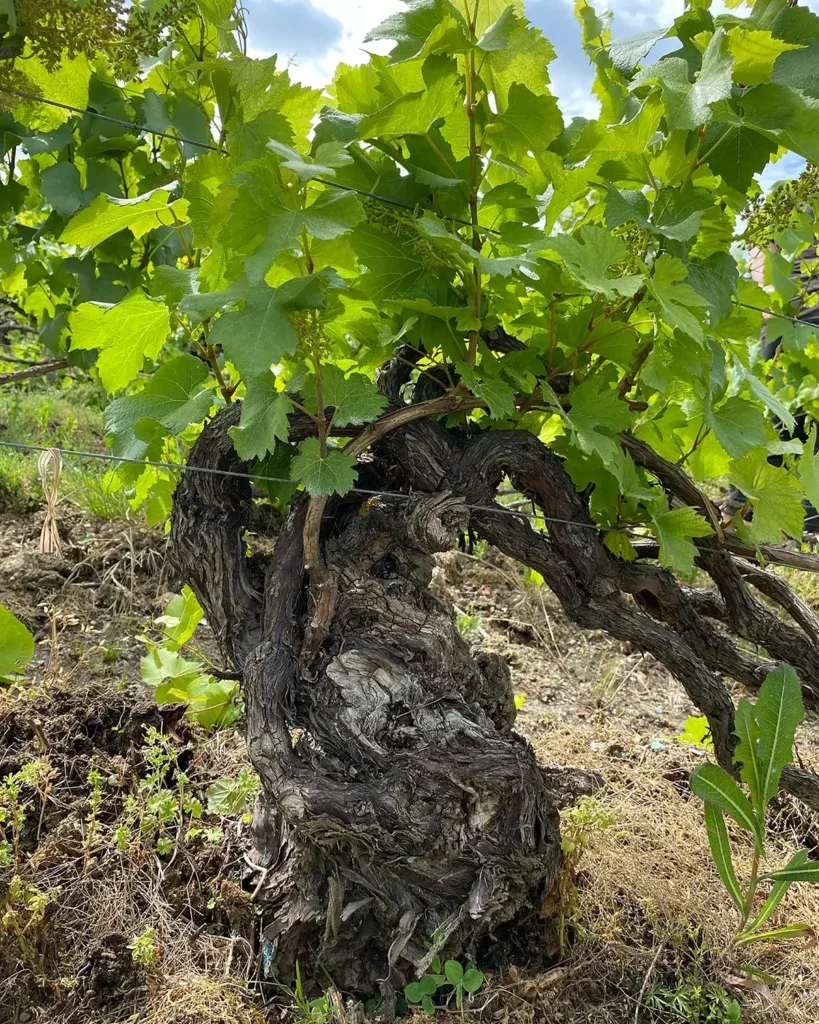
Rosé de Blancs, Brut, NV +
Base 2018, 95% CH, roughly half-half between Grand and 1er Cru, 6% Bouzy PN, disg 11/3/2021, diam cork
Didier’s non-rosé Rosé has often been helplessly charming. It’s hard to fathom the effect a mere 6% of PN can have, but stepping back a bit, a Côte des Blancs grower seeking to have a quicker-selling wine can easily be forgiven for making Rosé in a white-wine locality, and there’s now a sub-species of Champagne Rosé based fundamentally on white. Thus the questions: What does it add, and how good is it?
This one’s started out peevish even with 14 months on the cork, as opposed to the knee-buckling prettiness of last year’s. After a couple days, one’s knees were tempted to buckle once again. I deleted most of my original text—but bear in mind, if you own it, it could seem a bit austere when you first pour. It has that “Magnum” thing of suppressed fruit and exaggerated stiffness. The MacNeil glass seeks to dissolve the asperity and partly succeeds. It seems odd to counsel patience for a wine with 14 months on the cork, but I let my samples rest for 10 weeks before I’m broaching them, and this wine simply isn’t eager to be smashed into.
Except that it most definitely was, after a couple days. Champagne can be a mischievous little fiend, and it won’t do to judge it in the nano-second after its poured. For sheer prettiness this rivals some of Arnaud Margaine’s most fetching rosés.
Rosé de Blancs, Brut, NV MAGNUM +
This is assemblage 191, versus 208 for the above; it’s based on 2016 (as opposed to 2018), disg 9/18/2020 with similar proportions to the above.
Reading between the lines, Didier must have sussed he had something noteworthy here, in order to bottle Mags. With one sniff, his instinct makes sense. For this is a fetching and fascinating fragrance, and it leads to an equally lovely and only slightly immature palate.
I was watching the film Petite Maman a few nights ago, and was struck by how perfectly apt the music was to the dreamy drama. So many times a film score seems cloddishly designed to wrench your emotions into whatever the director wants you to feel, and it is rare when the music and the drama understand each other. I bring it up because, this is a musical wine but not (yet) an “emotional” one. It is significantly vinous and complex, as well as evanescent and aerial, and one wonders what its destiny may yet be.
To be clear, it was (in my Boston parlance) wicked smaht to bottle this in Mags. Something extra resides here. I try to stay clear of the business of predicting exactly how a wine will develop and precisely how good it will be, but even now there is a kind of tantric accord between the CdB minerality and the Bouzy fruit, and it teases with suggestion. And it strikes me, tasting this, how Gimonnet’s wines have an easy kind of grammar and a restrained lyric sense. There are riskier wines. There are more overtly “thrilling” wines. But I wonder about the quiet depths I see here; do they have an equivalent in Champagne? They’d have to, it would seem, but when I look for wines like these I find my mind a blank.
Jazz is about chops, right? It’s about players playing, and the audacity of their virtuosity. It’s exciting when they go for it, yet there’s a different kind of virtuosity, when a player resists the display of chops and plays what the music asks for. Sometimes it asks for chops! Other times the notes obscure the view. What I taste in a wine like this, and in many of Gimonnet’s wines, is what I might call “Play the notes that matter.” Sometimes a lot of notes, sometimes a few; sometimes at high volume and other times not. These are not wines for children. Neither are they wines for “experts” or intellectuals, but simply for people who taste (and drink) thoughtfully and calmly.
Gimonnet wines are imported and sold in the UK by Armit Wines and in the US by Skurnik Wines.

